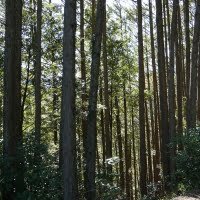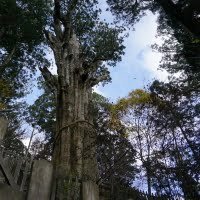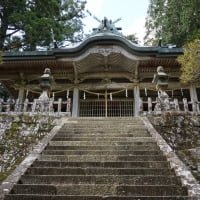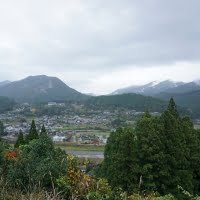Little did I know that Japan could be infused with deep spirituality and devotion. The land of manga, robots and bullet trains also has a religious side to it, with hundreds of temples and shrines all across the nation. Amid political and civil tensions in medieval Japan, the introduction and spread of esoteric Buddhism, Taoism and asceticism led to the construction of many temples, shrines and monasteries etc. With the opportunity to visit one such holy place in Japan I could witness the essence of Japanese faith and prayer. Kumano a popular pilgrimage site is located in the Kii peninsula. Shugendo or Shugen is a religion that contains elements of Shintoism, Buddhism, Taoism and also folk beliefs. It developed in the Kumano mountains, thus making it a holy ground. Before reaching Kumano we made a stop at Totsukawa village.
Totsukawa
Away from the bustling towns and cities, Totsukawa lies secluded in south Nara near the borders of Wakayama and Mie. It is said to be the largest village in Japan. The Kitayama River (originating in Wakayama) merges with the Totsukawa River in Nara and this same river is called Kumano River when it flows through Wakayama. Set in the middle of Kii peninsula, Totsukawa is held important for its landscapes and cultural heritage sites. Two important world heritage sites – Kumano Kodo and Tamaki Shrine are located in this area. Moreover, this place is blessed with untouched greenery and number of natural hot springs which make it a popular tourist destination.
The name of Totsukawa village has appeared several times in the Japanese history of Nanboku era (南北朝時代), a period during which Muromachi bakufu was in its nascent stage. The state was divided into the Northern and the Southern Imperial Courts, having two different rulers. The capital Northern Imperial Court was in Kyoto under Ashikaga Takauji and the capital of Southern Imperial Court was in Yoshino under Emperor Go-Daigo. There were constant conflicts between these two courts. On one such occasions, Moriyoshi Shinnō the son of Emperor Go-Daigo fled and took refuge in the Totsukawa village. Even though the Southern Court gave up, the stories of bravery and courage of its warriors have passed down the history.
A ride through the Gojō city brought us to the Tanize suspension bridge in the north of Totsukawa, and it connects Uenoji and Tanize. Built in 1954 with funds collected from all the villagers Tanize Bridge is 54m high and 297m long. This is the longest iron cable suspension bridge in japan. With all those swinging and wobbling in the center of the bridge I kept each step with caution and so it felt like it took ages to walk the full length. On the event of “Tsuribashi no Hi” on 4th of August every year, taiko drum performance is held on the bridge itself.
Our next destination was a quiet and lonely place, the innermost Kumano Sanzan shrine the Tamaki shrine. The mountain path leading up to Tamaki shrine was filled with a sweet aroma from the cedar forest. On the way we found a 3000 year old Jindai cedar that stood tall and mighty. The Tamaki mountain ranges are said to have formed due to an undersea volcanic eruption. The name Tamaki was derived from the legend which tells that Emperor Jimmu hid his ten heavenly jewels in this shrine before traveling to the east. The splendid view of the Kii mountain ranges from this area was breathtaking.
We stayed at Ichinoyu hotel, close to the Totsukawa village office. There is an open-air foot bath near this hotel. I didn’t miss the chance to recharge myself there for a few minutes. It was my first time staying at a Japanese-style inn. The room had tatami mats and we slept on futon. As for the dinner, we had “kaiseki”or Japanese meal course.
Kumano
On the following day we set for Kumano. As mentioned in the Kojiki, Izanami-no-Mikoto (the god who gave birth to the land of Japan) is buried in Kumano. Hongu Taisha, Nachi Taisha and Hayatama Taisha are the three main shrines of Kumano, collectively known as Kumano Sanzan. Kumano is close to the Kumano Sea that expands into the Pacific Ocean. The low clouds over the vast green mountain range asserted that Kumano is truly ”another world”. Since thousands of years saints and priests have been training and practicing healing methods in the mountains. When Buddhism fixed its roots in Japan, the Shinto deities were held to be the incarnations of Lord Buddha. Pilgrims including imperial families visited Kumano to worship and cure their ailments. With its increasing popularity during the Heian period, Kumano was expanded into a ritual ground and came to be known as the home of deities. Later the ‘Junishogongen’ or 12 avatars which included Shinto gods, princes and Buddhist Kannon figures were enshrined in Kumano.
The glorious Kumano Nachi Taisha has been a center of faith since long. Built at an altitude of 500m, one has to climb 467 stone steps to reach the shrine. Fusimi-no-kami, manifestation of Boddhisattva Senju Kannon is enshrined as the main god here. The Nachi Taisha’s guardian deity looks after agriculture and fisheries. 750m away from the shrine is the legendary Nachi fall (Nachi Taki) with a flawless single drop of 133m. The two rocks at mouth of the fall divide the single flow of water into three at the top. The most astonishing scenery here was the view of Nachi-Taki together with the three storied vermilion pagoda.
‘Yatagarasu’ or three legged crow is held important here. It is said that this divine creature guided emperror Jimmu on his way from Kumano to Yamato. The each leg represents gods, humans and nature and indicates that all three are brothers born under the same sun.
Close by Nachi Taisha, there is a temple called the Fudaraku-ji. The main god of worship is Kannon, the goddess of mercy. This temple is famous for Fudaraku Tokai, a religious practice where the one undertaking it would set off on a sea voyage in search of Kannon’s paradise, on a single-sail boat with food and fuel that would suffice a month.
Next we reached Hayatama Taisha in Shingu, a shrine dedicated to god Hayatama. This is one of the shrines of Kumano Sanzan. There is also a treasure hall near the shrine which has preserved rare and interesting artifacts including ritualistic objects which are said to have been donated by the Ashikaga Shoguns in the 15th century.
We put up in a classy Japanese style hotel for the day. It was the Sasayuri hotel of Watarase onsen. The soothing sound of the river, a private hot bath facility, spacious rooms and delicious food, this hotel was just wonderful. This area is well-known for plum and oranges. I also tried some local dishes like `meharizushi`.
On the following day, we were all set for covering the remaining sites of Kumano holy trail. At first we reached the Kumano Hongu Taisha. Ketsumi-miko the incarnation of Amida-Nyorai is the main god of worship here. This shrine was originally built in Oyunohara until a severe flood in 1889. Oyunohara is a large delta at the confluence of Kumano and Otonashi River. A 33.9 m tall and 42 m wide gate (tori) marks the entry to Oyunohara.
The last stop was Toukei shrine or Gongen-san. As the Genpei war (a battle between the Genji and Heike clan) changed from land warfare of Ichinotani to sea warfare, the movements of the Kumano navy which was the strongest navy in Japan at that time, had a strong effect on the situation. Both Genji and Heike approached the leader (Betto Tanzo) of Kumano navy for support. Beinkei on Yoshitsune’s order (from Genji’s side) hastened back to Tanabe to speak with his father Tanzo. To confirm God’s wishes Tanzo ordered seven cocks with red feathers to fight seven cocks with white feathers representing Heike clan and Genji clan respectively. The white ones won and so Tenzo decided to team up with the Genji clan. The battle was fought in Dannoura, Yamaguchi prefecture and concluded with the victory of Genji clan in 1185.
- Nachi Falls
































